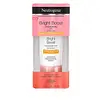What's inside
What's inside
 Key Ingredients
Key Ingredients

 Benefits
Benefits

 Concerns
Concerns

 Ingredients Side-by-side
Ingredients Side-by-side

Butyl Methoxydibenzoylmethane 1.5%
UV AbsorberHomosalate 5%
Skin ConditioningEthylhexyl Salicylate 4%
UV AbsorberOctocrylene 6%
UV AbsorberWater
Skin ConditioningGlycerin
HumectantCaprylyl Methicone
Skin ConditioningDiisopropyl Adipate
EmollientAcetyl Glucosamine
Skin ConditioningSilica
AbrasiveDimethicone
EmollientDicaprylyl Carbonate
EmollientSodium Acryloyldimethyltaurate/Vp Crosspolymer
Emulsion StabilisingPolyurethane-62
Caprylyl Glycol
EmollientPhenoxyethanol
PreservativeDimethicone Crosspolymer
Emulsion StabilisingParfum
MaskingGlyceryl Stearate
EmollientChlorphenesin
AntimicrobialTocopheryl Acetate
AntioxidantSodium Ascorbyl Phosphate
AntioxidantCitric Acid
BufferingDisodium EDTA
Trideceth-6
EmulsifyingMoringa Oleifera Seed Extract
Skin ConditioningMica
Cosmetic ColorantTitanium Dioxide
Cosmetic ColorantButyl Methoxydibenzoylmethane 1.5%, Homosalate 5%, Ethylhexyl Salicylate 4%, Octocrylene 6%, Water, Glycerin, Caprylyl Methicone, Diisopropyl Adipate, Acetyl Glucosamine, Silica, Dimethicone, Dicaprylyl Carbonate, Sodium Acryloyldimethyltaurate/Vp Crosspolymer, Polyurethane-62, Caprylyl Glycol, Phenoxyethanol, Dimethicone Crosspolymer, Parfum, Glyceryl Stearate, Chlorphenesin, Tocopheryl Acetate, Sodium Ascorbyl Phosphate, Citric Acid, Disodium EDTA, Trideceth-6, Moringa Oleifera Seed Extract, Mica, Titanium Dioxide
Water
Skin ConditioningGlycerin
HumectantPentylene Glycol
Skin ConditioningButylene Glycol
HumectantDimethicone
EmollientPEG-8
HumectantAmmonium Acryloyldimethyltaurate/Beheneth-25 Methacrylate Crosspolymer
Emulsion StabilisingCaprylyl Glycol
EmollientCarbomer
Emulsion StabilisingCitric Acid
BufferingGlyceryl Acrylate/Acrylic Acid Copolymer
HumectantHamamelis Virginiana Leaf Water
AstringentNiacinamide
SmoothingPEG-40 Hydrogenated Castor Oil
EmulsifyingPhenoxyethanol
PreservativePolyvinyl Alcohol
Potassium Carbonate
BufferingPotassium Hydroxide
BufferingPvm/Ma Copolymer
Emulsion StabilisingSaccharide Isomerate
HumectantSodium Citrate
BufferingSodium Lactate
BufferingT-Butyl Alcohol
PerfumingThymus Vulgaris Flower/Leaf Extract
MaskingTrideceth-9
EmulsifyingZinc PCA
HumectantWater, Glycerin, Pentylene Glycol, Butylene Glycol, Dimethicone, PEG-8, Ammonium Acryloyldimethyltaurate/Beheneth-25 Methacrylate Crosspolymer, Caprylyl Glycol, Carbomer, Citric Acid, Glyceryl Acrylate/Acrylic Acid Copolymer, Hamamelis Virginiana Leaf Water, Niacinamide, PEG-40 Hydrogenated Castor Oil, Phenoxyethanol, Polyvinyl Alcohol, Potassium Carbonate, Potassium Hydroxide, Pvm/Ma Copolymer, Saccharide Isomerate, Sodium Citrate, Sodium Lactate, T-Butyl Alcohol, Thymus Vulgaris Flower/Leaf Extract, Trideceth-9, Zinc PCA
 Reviews
Reviews

Ingredients Explained
These ingredients are found in both products.
Ingredients higher up in an ingredient list are typically present in a larger amount.
Caprylyl Glycol is a humectant and emollient, meaning it attracts and preserves moisture.
It is a common ingredient in many products, especially those designed to hydrate skin. The primary benefits are retaining moisture, skin softening, and promoting a healthy skin barrier.
Though Caprylyl Glycol is an alcohol derived from fatty acids, it is not the kind that can dry out skin.
This ingredient is also used as a preservative to extend the life of products. It has slight antimicrobial properties.
Learn more about Caprylyl GlycolCitric Acid is an alpha hydroxy acid (AHA) naturally found in citrus fruits like oranges, lemons, and limes.
Like other AHAs, citric acid can exfoliate skin by breaking down the bonds that hold dead skin cells together. This helps reveal smoother and brighter skin underneath.
However, this exfoliating effect only happens at high concentrations (20%) which can be hard to find in cosmetic products.
Due to this, citric acid is usually included in small amounts as a pH adjuster. This helps keep products slightly more acidic and compatible with skin's natural pH.
In skincare formulas, citric acid can:
While it can provide some skin benefits, research shows lactic acid and glycolic acid are generally more effective and less irritating exfoliants.
Most citric acid used in skincare today is made by fermenting sugars (usually from molasses). This synthetic version is identical to the natural citrus form but easier to stabilize and use in formulations.
Read more about some other popular AHA's here:
Learn more about Citric AcidDimethicone is a type of synthetic silicone created from natural materials such as quartz.
What it does:
Dimethicone comes in different viscosities:
Depending on the viscosity, dimethicone has different properties.
Ingredients lists don't always show which type is used, so we recommend reaching out to the brand if you have questions about the viscosity.
This ingredient is unlikely to cause irritation because it does not get absorbed into skin. However, people with silicone allergies should be careful about using this ingredient.
Note: Dimethicone may contribute to pilling. This is because it is not oil or water soluble, so pilling may occur when layered with products. When mixed with heavy oils in a formula, the outcome is also quite greasy.
Learn more about DimethiconeGlycerin is already naturally found in your skin. It helps moisturize and protect your skin.
A study from 2016 found glycerin to be more effective as a humectant than AHAs and hyaluronic acid.
As a humectant, it helps the skin stay hydrated by pulling moisture to your skin. The low molecular weight of glycerin allows it to pull moisture into the deeper layers of your skin.
Hydrated skin improves your skin barrier; Your skin barrier helps protect against irritants and bacteria.
Glycerin has also been found to have antimicrobial and antiviral properties. Due to these properties, glycerin is often used in wound and burn treatments.
In cosmetics, glycerin is usually derived from plants such as soybean or palm. However, it can also be sourced from animals, such as tallow or animal fat.
This ingredient is organic, colorless, odorless, and non-toxic.
Glycerin is the name for this ingredient in American English. British English uses Glycerol/Glycerine.
Learn more about GlycerinPhenoxyethanol is a preservative that has germicide, antimicrobial, and aromatic properties. Studies show that phenoxyethanol can prevent microbial growth. By itself, it has a scent that is similar to that of a rose.
It's often used in formulations along with Caprylyl Glycol to preserve the shelf life of products.
Water. It's the most common cosmetic ingredient of all. You'll usually see it at the top of ingredient lists, meaning that it makes up the largest part of the product.
So why is it so popular? Water most often acts as a solvent - this means that it helps dissolve other ingredients into the formulation.
You'll also recognize water as that liquid we all need to stay alive. If you see this, drink a glass of water. Stay hydrated!
Learn more about Water